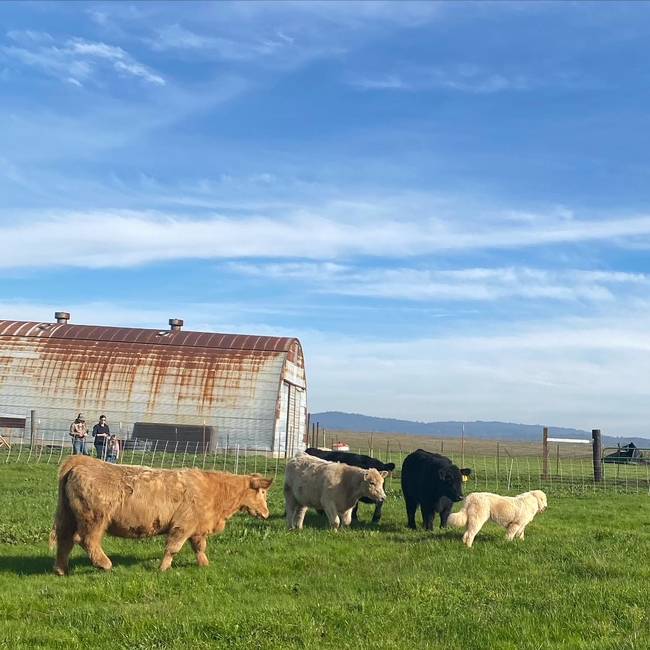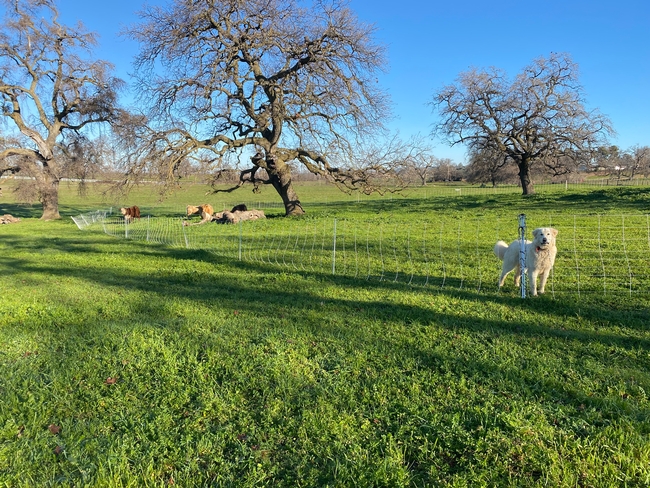If you've been following our effort to demonstrate techniques for bonding livestock guardian dogs (LGDs) with cattle (either on this blog or through my @flyingmulefarm Twitter or Facebook accounts), you'll know that Sam the LGD pup got off to a great start on large cattle operation in Modoc County in 2021. But after their first significant snowfall of the year, and the realization that their heifers would begin calving shortly after the Holidays, the ranch decided that they simply didn't have the bandwidth to continue with the project. In the week before Christmas, I brought Sam back to Placer County – he spent the Holidays with my sheep and one of my mature LGDs, Bodie.
During Sam's “vacation,” I happened to visit with JC Baser, a local cattle producer who has experienced increasing problems with coyotes during his last several calving seasons. JC is on the board of our local Tahoe Cattlemen's Association, and his whole family is involved in their operation. He'd heard me talk about the project at board meetings, and called me one morning to talk in more detail.
The Baser's ranch is typical of many foothill cattle operations. They graze on leased rangeland in the winter time, and leased and owned irrigated pasture in the summer time. Perhaps atypically, however, they've created a great market for show cattle – fair steers and fancy heifers. They're also innovators when it comes to reproductive technology – utilizing artificial insemination and other techniques to continuously improve their genetics. And from the perspective of this project, they're willing to try new things!
After the first of the year, I toured the Baser's winter ranch, where they're currently calving. The following week, I worked with Garrett and Levi (JC and Michelle's sons) to set up an electro-net paddock near their barn. They put four heifers in the paddock; I added Sam. And the demonstration project was off and running in a new location!
Sam is now nearly 8 months old – in the midst of his “terrible teens” (the time period with most young LGDs seem to be puppy enough to want to play but big enough to play too roughly with livestock). As we introduced him to his new environment, he took special interest in JC and Michelle's youngest daughter (who's 5 years old). They've since reported that he continues to be fixated on her when she's nearby – and so they've limited her contact with Sam (since we want Sam to bond with cattle rather than people).
When we introduced Sam to the heifers, he barked a bit and tried to keep them away from us. I walked through the heifers and growled at Sam if he looked like he wanted to chase. Within about 10 minutes, he'd settled in. The heifers also seemed to settle – they were curious about their new fuzzy white pasture mate, but they quickly went back to grazing.
That was all 13 days ago. Yesterday, I visited the Basers and got an update on Sam's progress. They reported that for the first several days, when they arrived (and Sam knew they were there), he would herd the heifers around the paddock, nipping at their heels. On the occasions where they could observe Sam without his knowledge, however, he was content to be with his cattle. Late last week, they added an older dry cow to the mix. Sam tried to keep her separated from the heifers for about 10 minutes, but then settled back down. Today, he was excited to see me – and followed me through the paddock as I went to see the cattle. Once I was back outside the fence, however, he decided he'd rather be with the cattle than watch us – all positive signs.
The Basers also reported that Sam definitely barks at external stimuli – whether it's the rancher next door checking his cattle, or the sound of a coyote. This responsiveness is perhaps the most important tool in and LGDs tool box – in some cases, announcing their presence (through barking and scent marking) appears to deter predators.
Our next steps with Sam will be to introduce several cows with older calves at their sides. I suspect this introduction will be a two-way process – mother cows can be protective of their calves, so they may be more suspicious of the dog in their pasture. Conversely, Sam needs to get comfortable with the entire herd – and with the changes that occur (calving, weaning, etc.) in any commercial livestock setting. I'm hopeful he'll handle this new transition well, but we'll be watching closely.
For now, Sam remains inside an electro-net paddock, which keeps him with “his” cattle. Eventually, we hope that he'll be well-enough bonded with the ranch livestock that we won't need the eletro-net. We'll also work to get him trained to eat from an automatic feeder in a creep-feeding set-up – the labor of daily feeding is one of the drawbacks that many ranchers cite about using LGDs. And, like the final exam we subject our sheep-guarding dogs to, Sam will need to prove trustworthy during the calving process. These are all developments that will hopefully be natural as Sam matures. For now, however, he continues to make the progress I'd expect from an 8-month-old dog.
